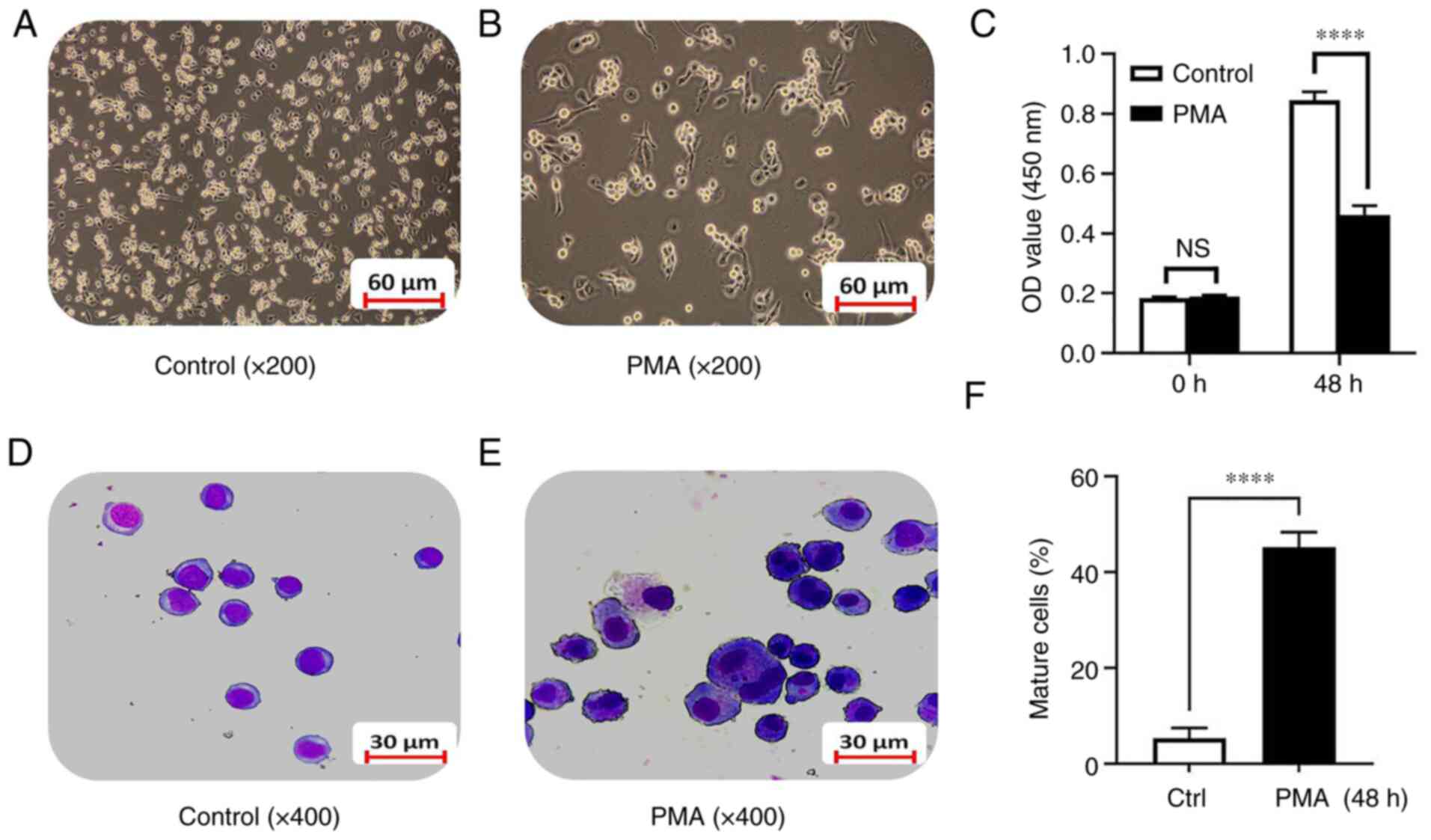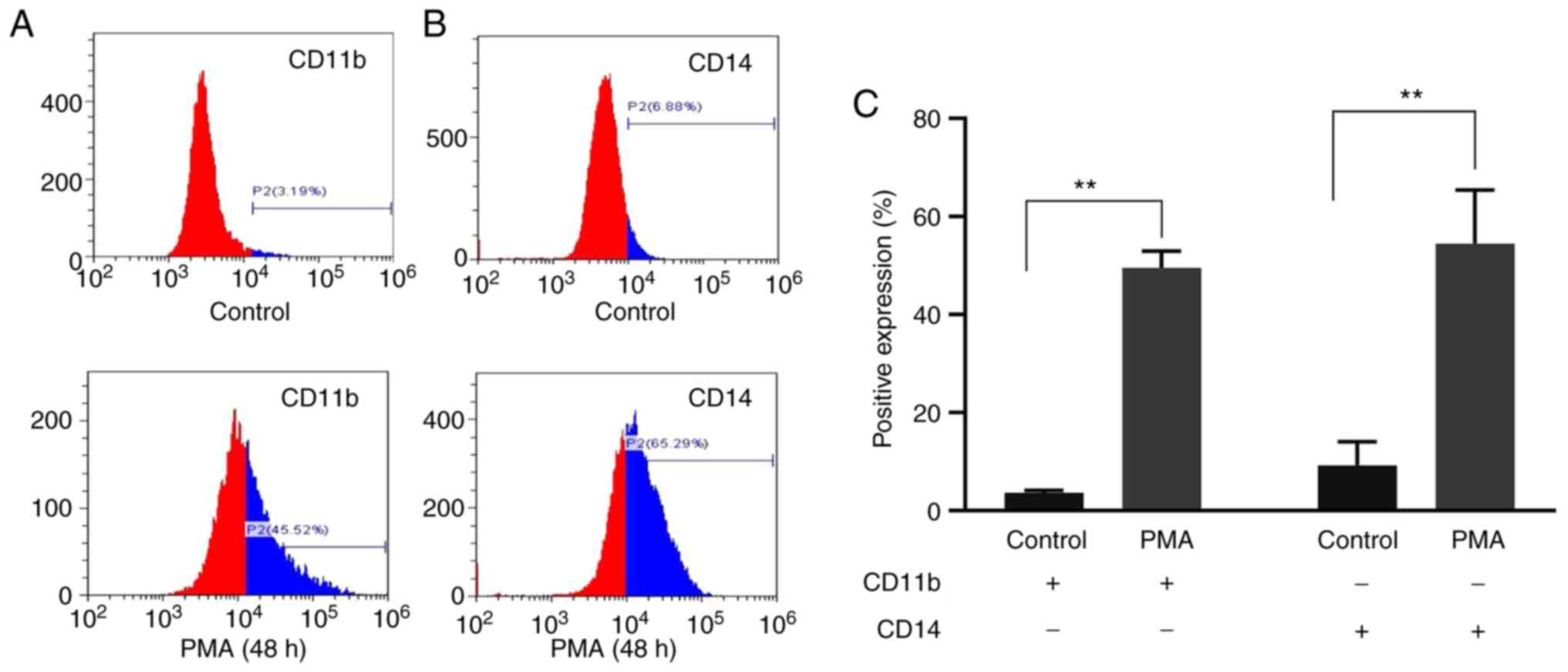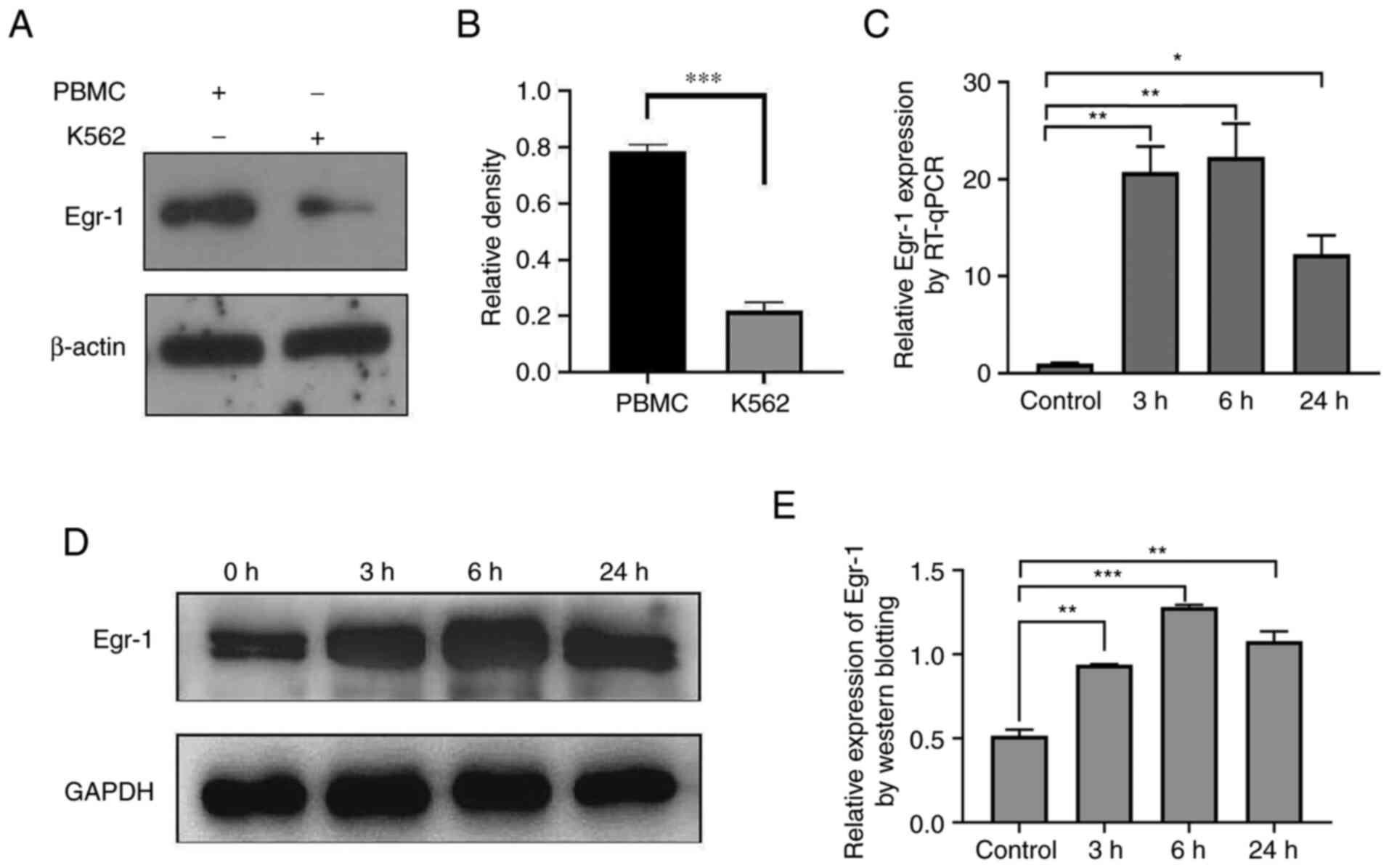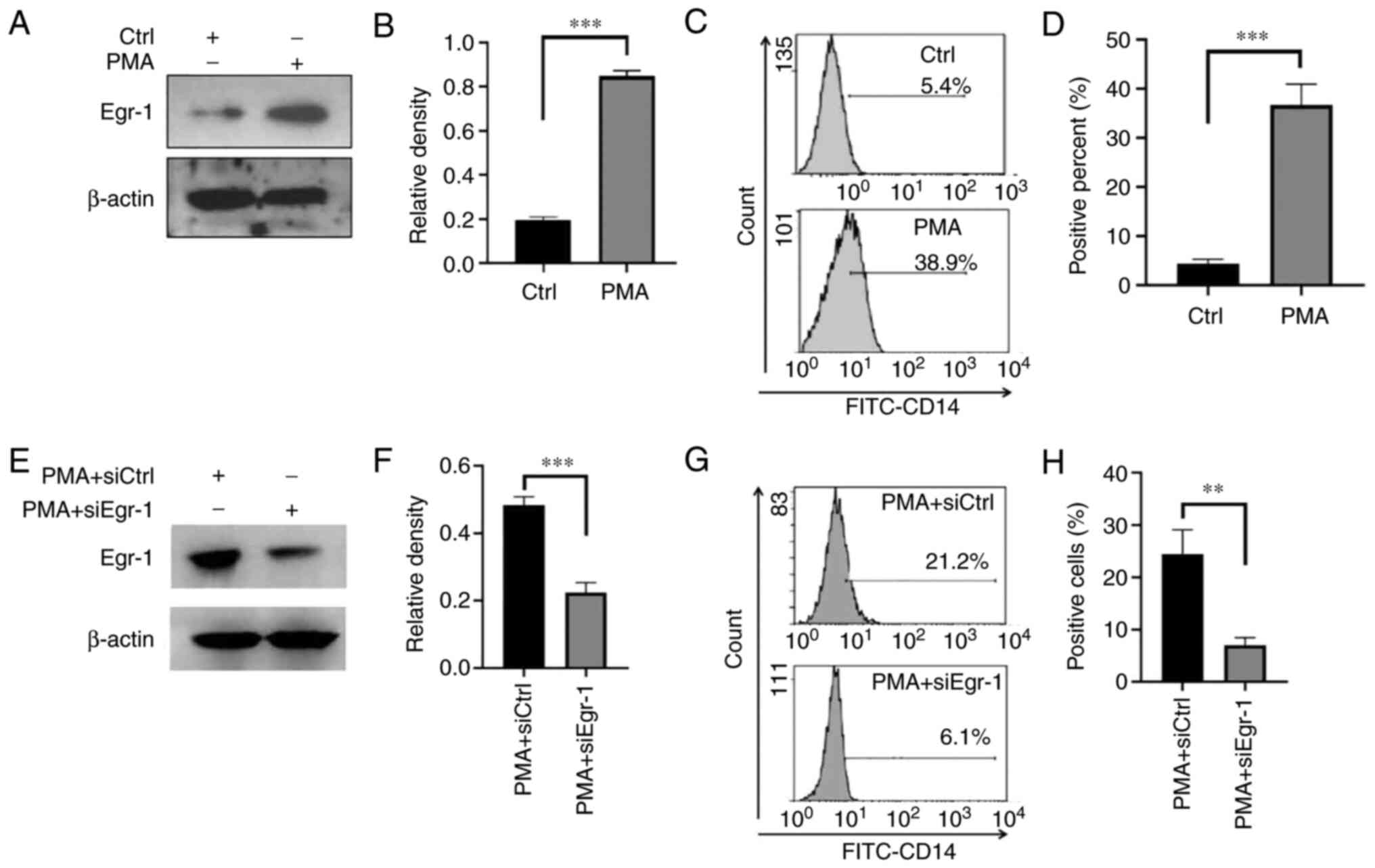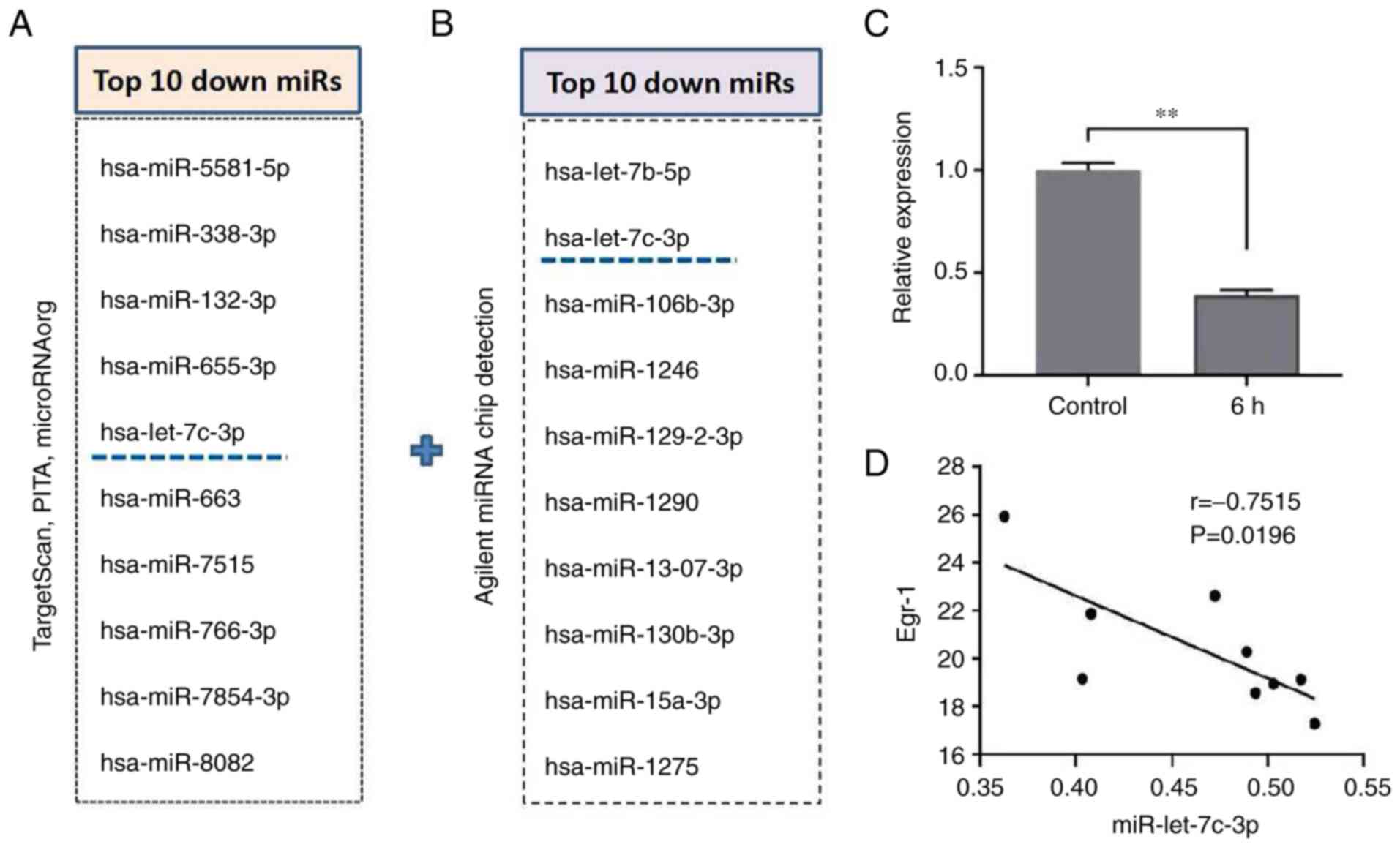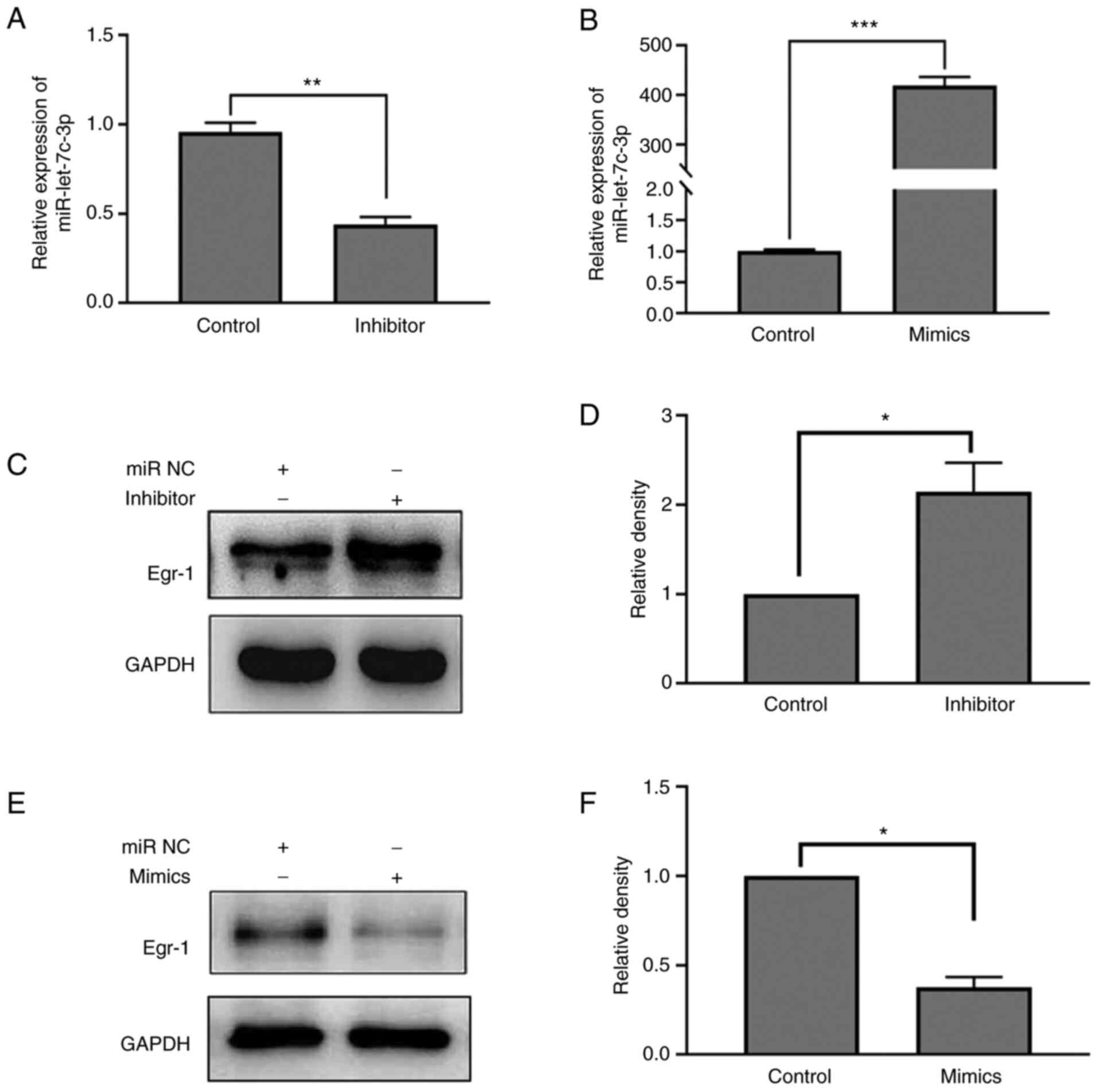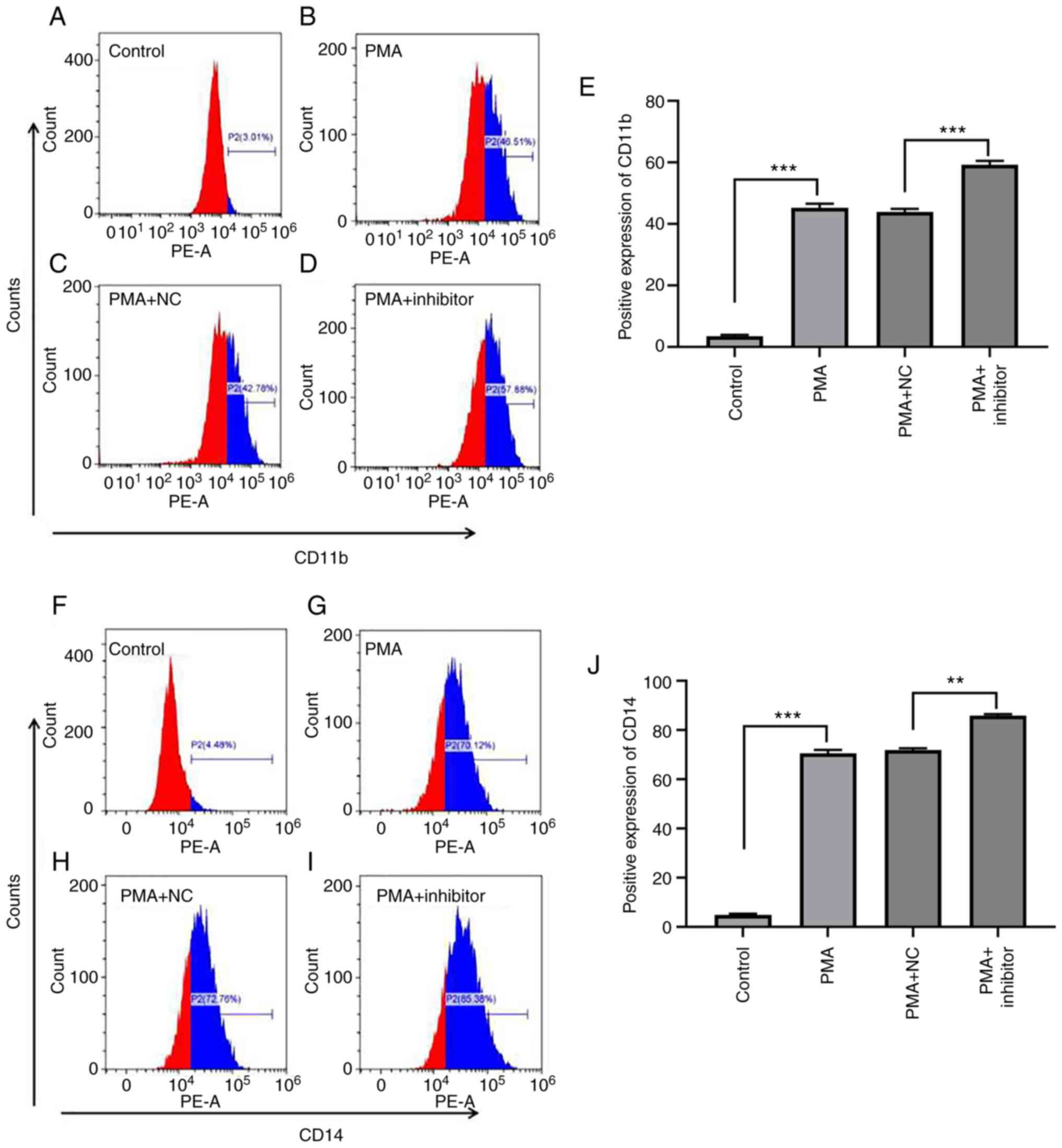|
1
|
Liu YH, Zhu M, Lei PP, Pan XY and Ma WN:
ND-09 inhibits chronic myeloid leukemia K562 cell growth by
regulating BCR-ABL signaling. Oncol Rep. 46:1362021. View Article : Google Scholar : PubMed/NCBI
|
|
2
|
Yao FY, Zhao C, Zhong FM, Qin TY, Wen F,
Li MY, Liu J, Huang B and Wang XZ: m(6)A modification of lncRNA
NEAT1 regulates chronic myelocytic leukemia progression via
miR-766-5p/CDKN1A axis. Front Oncol. 11:6796342021. View Article : Google Scholar : PubMed/NCBI
|
|
3
|
Cai SF and Levine RL: Genetic and
epigenetic determinants of AML pathogenesis. Semin. Hematol.
56:84–89. 2019.PubMed/NCBI
|
|
4
|
Padmakumar D, Chandraprabha VR, Gopinath
P, Vimala Devi ART, Anitha GRJ, Sreelatha MM, Padmakumar A and
Sreedharan H: A concise review on the molecular genetics of acute
myeloid leukemia. Leuk Res. 111:1067272021. View Article : Google Scholar : PubMed/NCBI
|
|
5
|
Bhat AA, Younes SN, Raza SS, Zarif L,
Nisar S, Ahmed I, Mir R, Kumar S, Sharawat SK, Hashem S, et al:
Role of non-coding RNA networks in leukemia progression, metastasis
and drug resistance. Mol Cancer. 19:572020. View Article : Google Scholar : PubMed/NCBI
|
|
6
|
Schwarzer A, Emmrich S, Schmidt F, Beck D,
Ng M, Reimer C, Adams FF, Grasedieck S, Witte D, Käbler S, et al:
The non-coding RNA landscape of human hematopoiesis and leukemia.
Nat Commun. 8:2182017. View Article : Google Scholar : PubMed/NCBI
|
|
7
|
de Thé H: Differentiation therapy
revisited. Nat Rev Cancer. 18:117–127. 2018. View Article : Google Scholar : PubMed/NCBI
|
|
8
|
Madan V and Koeffler HP: Differentiation
therapy of myeloid leukemia: Four decades of development.
Haematologica. 106:26–38. 2021.PubMed/NCBI
|
|
9
|
Yen JH, Lin CY, Chuang CH, Chin HK, Wu MJ
and Chen PY: Nobiletin promotes megakaryocytic differentiation
through the MAPK/ERK-dependent EGR1 expression and exerts
anti-leukemic effects in human chronic myeloid leukemia (CML) K562
cells. Cells. 9:8772020. View Article : Google Scholar : PubMed/NCBI
|
|
10
|
Josa-Culleré L, Madden KS, Cogswell TJ,
Jackson TR, Carter TS, Zhang D, Trevitt G, Davies SG, Vyas P, Wynne
GM, et al: A phenotypic screen identifies a compound series that
induces differentiation of acute myeloid leukemia cells in vitro
and shows antitumor effects in vivo. J Med Chem. 64:15608–15628.
2021. View Article : Google Scholar : PubMed/NCBI
|
|
11
|
Pinto CA, DE Sousa Portilho AJ, Barbosa
MC, DE Moraes MEA, DE Lemos JAR, Burbano RMR and Moreira-Nunes CA:
Combined therapy of ATRA and imatinib mesylate decreases BCR-ABL
and ABCB1/MDR1 expression through cellular differentiation in a
chronic myeloid leukemia model. In Vivo. 35:2661–2667. 2021.
View Article : Google Scholar : PubMed/NCBI
|
|
12
|
Mishra M, Thacker G, Sharma A, Singh AK,
Upadhyay V, Sanyal S, Verma SP, Tripathi AK, Bhatt MLB and Trivedi
AK: FBW7 inhibits myeloid differentiation in acute myeloid leukemia
via GSK3-dependent ubiquitination of PU.1. Mol Cancer Res.
19:261–273. 2021. View Article : Google Scholar : PubMed/NCBI
|
|
13
|
Huang Q, Wang L, Ran Q, Wang J, Wang C, He
H, Li L and Qi H: Notopterol-induced apoptosis and differentiation
in human acute myeloid leukemia HL-60 cells. Drug Des Devel Ther.
13:1927–1940. 2019. View Article : Google Scholar : PubMed/NCBI
|
|
14
|
Dembitz V, Lalic H, Tomic B, Smoljo T,
Batinic J, Dubravcic K, Batinic D, Bedalov A and Visnjic D:
All-trans retinoic acid induces differentiation in primary acute
myeloid leukemia blasts carrying an inversion of chromosome 16. Int
J Hematol. 115:43–53. 2022. View Article : Google Scholar : PubMed/NCBI
|
|
15
|
Minamiguchi H, Fujita H, Atsuta Y, Asou N,
Sakura T, Ueda Y, Sawa M, Dobashi N, Taniguchi Y, Suzuki R, et al:
Predictors of early death, serious hemorrhage, and differentiation
syndrome in Japanese patients with acute promyelocytic leukemia.
Ann Hematol. 99:2787–2800. 2020. View Article : Google Scholar : PubMed/NCBI
|
|
16
|
Shao S, Ju M, Lei J, Lu X, Li H, Wang D
and Xia C: Egr-1 inhibits colon cancer cell proliferation,
migration and invasion via regulating CDKL1 at the transcriptional
level. Oncol Rep. 46:1692021. View Article : Google Scholar : PubMed/NCBI
|
|
17
|
Su B, Wang X, Sun Y, Long M, Zheng J, Wu W
and Li L: miR-30e-3p promotes cardiomyocyte autophagy and inhibits
apoptosis via regulating Egr-1 during ischemia/hypoxia. Biomed Res
Int. 2020:72312432020. View Article : Google Scholar : PubMed/NCBI
|
|
18
|
Du K, Wu X, Ji X, Liang N and Li Z: Early
growth response 1 promoted the invasion of glioblastoma multiforme
by elevating HMGB1. J Neurosurg Sci. Dec 9–2020.(Epub ahead of
print). View Article : Google Scholar
|
|
19
|
Chen J, Zhan Y, Xu J, Wang Y and Gao Q:
EGR1 overexpression inhibits the occurrence of preeclampsia by
binding to MicroRNA-574 promoter and upregulating GAB1. Reprod Sci.
28:1112–1121. 2021. View Article : Google Scholar : PubMed/NCBI
|
|
20
|
Squires A, Atas E and Meller A: Nanopore
sensing of individual transcription factors bound to DNA. Sci Rep.
5:116432015. View Article : Google Scholar : PubMed/NCBI
|
|
21
|
Thiel G and Cibelli G: Regulation of life
and death by the zinc finger transcription factor Egr-1. J Cell
Physiol. 193:287–292. 2002. View Article : Google Scholar : PubMed/NCBI
|
|
22
|
Jiang C, Hu X, Wang L, Cheng H, Lin Y,
Pang Y, Yuan W, Cheng T and Wang J: Excessive proliferation and
impaired function of primitive hematopoietic cells in bone marrow
due to senescence post chemotherapy in a T cell acute lymphoblastic
leukemia model. J Transl Med. 13:2342015. View Article : Google Scholar : PubMed/NCBI
|
|
23
|
Cera AA, Cacci E, Toselli C, Cardarelli S,
Bernardi A, Gioia R, Giorgi M, Poiana G and Biagioni S: Egr-1
maintains NSC proliferation and its overexpression counteracts cell
cycle exit triggered by the withdrawal of epidermal growth factor.
Dev Neurosci. 40:223–233. 2018. View Article : Google Scholar : PubMed/NCBI
|
|
24
|
Zhang L, Ren R, Yang X, Ge Y, Zhang X and
Yuan H: Oncogenic role of early growth response-1 in liver cancer
through the regulation of the microRNA-675/sestrin 3 and the
Wnt/β-catenin signaling pathway. Bioengineered. 12:5305–5322. 2021.
View Article : Google Scholar : PubMed/NCBI
|
|
25
|
Lu J, Zhong C, Luo J, Shu F, Lv D, Liu Z,
Tan X, Wang S, Wu K, Yang T, et al: HnRNP-L-regulated
circCSPP1/miR-520h/EGR1 axis modulates autophagy and promotes
progression in prostate cancer. Mol Ther Nucleic Acids. 26:927–944.
2021. View Article : Google Scholar : PubMed/NCBI
|
|
26
|
Kimpara S, Lu L, Hoang NM, Zhu F, Bates
PD, Daenthanasanmak A, Zhang S, Yang DT, Kelm A, Liu Y, et al: EGR1
addiction in diffuse large B-cell lymphoma. Mol Cancer Res.
19:1258–1269. 2021. View Article : Google Scholar : PubMed/NCBI
|
|
27
|
Gibbs JD, Liebermann DA and Hoffman B:
Egr-1 abrogates the E2F-1 block in terminal myeloid differentiation
and suppresses leukemia. Oncogene. 27:98–106. 2008. View Article : Google Scholar : PubMed/NCBI
|
|
28
|
Racine RR, Manalo NA, Hall JMF, Dibas A,
Raffel GD and Mummert ME: CD44 induced enhancement of phosphatase
activity and calcium influx: Modifications of EGR-1 expression and
cell proliferation. Biochem Biophys Rep. 6:172–178. 2016.PubMed/NCBI
|
|
29
|
Zhao F, Yang Z, Gu X, Feng L, Xu M and
Zhang X: miR-92b-3p regulates cell cycle and apoptosis by targeting
CDKN1C, thereby affecting the sensitivity of colorectal cancer
cells to chemotherapeutic drugs. Cancers (Basel). 13:33232021.
View Article : Google Scholar : PubMed/NCBI
|
|
30
|
Kou N, Liu S, Li X, Li W, Zhong W, Gui L,
Chai S, Ren X, Na R, Zeng T and Liu H: H19 facilitates tongue
squamous cell carcinoma migration and invasion via sponging
miR-let-7. Oncol Res. 27:173–182. 2019. View Article : Google Scholar : PubMed/NCBI
|
|
31
|
Han X, Zhang JJ, Han ZQ, Zhang HB and Wang
ZA: Let-7b attenuates cisplatin resistance and tumor growth in
gastric cancer by targeting AURKB. Cancer Gene Ther. 25:300–308.
2018. View Article : Google Scholar : PubMed/NCBI
|
|
32
|
Chen H, Wang J, Wang H, Liang J, Dong J,
Bai H and Jiang G: Advances in the application of Let-7 microRNAs
in the diagnosis, treatment and prognosis of leukemia. Oncol Lett.
23:12022. View Article : Google Scholar : PubMed/NCBI
|
|
33
|
Livak KJ and Schmittgen TD: Analysis of
relative gene expression data using real-time quantitative PCR and
the 2(−Delta Delta C(T)) method. Methods. 25:402–408. 2001.
View Article : Google Scholar : PubMed/NCBI
|
|
34
|
Shi M, Ren X, Wang X, Wang H, Liu G, Yuan
X, Zheng S, Yu L, Pan S, Song G, et al: A novel combination of
oridonin and valproic acid in enhancement of apoptosis induction of
HL-60 leukemia cells. Int J Oncol. 48:734–746. 2016. View Article : Google Scholar : PubMed/NCBI
|
|
35
|
Song G, Shi L, Guo Y, Yu L, Wang L, Zhang
X, Li L, Han Y, Ren X, Guo Q, et al: A novel PAD4/SOX4/PU.1
signaling pathway is involved in the committed differentiation of
acute promyelocytic leukemia cells into granulocytic cells.
Oncotarget. 7:3144–3157. 2016. View Article : Google Scholar : PubMed/NCBI
|
|
36
|
Li L, Wang Y, Zhang X, Song G, Guo Q,
Zhang Z, Diao Y, Yin H, Liu H and Jiang G: Deubiquitinase USP48
promotes ATRA-induced granulocytic differentiation of acute
promyelocytic leukemia cells. Int J Oncol. 53:895–903.
2018.PubMed/NCBI
|
|
37
|
Chou CC and Hsu CY: Involvement of PKC in
TPA-potentiated apoptosis induction during hemin-mediated erythroid
differentiation in K562 cells. Naunyn Schmiedebergs Arch Pharmacol.
379:1–9. 2009. View Article : Google Scholar : PubMed/NCBI
|
|
38
|
Zhang C, Guo LY, Mu D, Gong JH and Chen J:
Induction of apoptosis and erythroid differentiation of human
chronic myelogenous leukemia K562 cells by low concentrations of
lidamycin. Oncol Rep. 41:475–482. 2019.PubMed/NCBI
|
|
39
|
Tian J, Li Z, Han Y, Jiang T, Song X and
Jiang G: The progress of early growth response factor 1 and
leukemia. Intractable Rare Dis Res. 5:76–82. 2016. View Article : Google Scholar : PubMed/NCBI
|
|
40
|
Park YS, Kim HS, Kim JH, Choi SH, Kim DS,
Ryoo ZY, Kim JY and Lee S: NAB2-STAT6 fusion protein mediates cell
proliferation and oncogenic progression via EGR-1 regulation.
Biochem Biophys Res Commun. 526:287–292. 2020. View Article : Google Scholar : PubMed/NCBI
|
|
41
|
Zhang M, Liao Y and Lönnerdal B: EGR-1 is
an active transcription factor in TGF-β2-mediated small intestinal
cell differentiation. J Nutr Biochem. 37:101–108. 2016. View Article : Google Scholar : PubMed/NCBI
|
|
42
|
Toan NK, Tai NC, Kim SA and Ahn SG:
Soluble Klotho regulates bone differentiation by upregulating
expression of the transcription factor EGR-1. FEBS Lett.
594:290–300. 2020. View Article : Google Scholar : PubMed/NCBI
|
|
43
|
Myung DS, Park YL, Kim N, Chung CY, Park
HC, Kim JS, Cho SB, Lee WS, Lee JH and Joo YE: Expression of early
growth response-1 in colorectal cancer and its relation to tumor
cell proliferation and apoptosis. Oncol Rep. 31:788–794. 2014.
View Article : Google Scholar : PubMed/NCBI
|
|
44
|
Zins K, Pomyje J, Hofer E, Abraham D,
Lucas T and Aharinejad S: Egr-1 upregulates Siva-1 expression and
induces cardiac fibroblast apoptosis. Int J Mol Sci. 15:1538–1553.
2014. View Article : Google Scholar : PubMed/NCBI
|
|
45
|
Jeong SH, Kim HJ, Jang Y, Ryu WI, Lee H,
Kim JH, Bae HC, Choi JE, Kye YC and Son SW: Egr-1 is a key
regulator of IL-17A-induced psoriasin upregulation in psoriasis.
Exp Dermatol. 23:890–895. 2014. View Article : Google Scholar : PubMed/NCBI
|
|
46
|
Yeo H, Ahn SS, Lee JY and Shin SY: EGR-1
acts as a transcriptional activator of KLK7 under IL-13
stimulation. Biochem Biophys Res Commun. 534:303–309. 2021.
View Article : Google Scholar : PubMed/NCBI
|
|
47
|
Wang Q, Salman H, Danilenko M and
Studzinski GP: Cooperation between antioxidants and
1,25-dihydroxyvitamin D3 in induction of leukemia HL60 cell
differentiation through the JNK/AP-1/Egr-1 pathway. J Cell Physiol.
204:964–974. 2005. View Article : Google Scholar : PubMed/NCBI
|
|
48
|
Bestilny LJ and Riabowol KT: A role for
serine proteases in mediating phorbol ester-induced differentiation
of HL-60 cells. Exp Cell Res. 256:264–271. 2000. View Article : Google Scholar : PubMed/NCBI
|
|
49
|
Liu C, Calogero A, Ragona G, Adamson E and
Mercola D: EGR-1, the reluctant suppression factor: EGR-1 is known
to function in the regulation of growth, differentiation, and also
has significant tumor suppressor activity and a mechanism involving
the induction of TGF-beta1 is postulated to account for this
suppressor activity. Crit Rev Oncog. 7:101–125. 1996. View Article : Google Scholar : PubMed/NCBI
|
|
50
|
Li TT, Liu MR and Pei DS: Friend or foe,
the role of EGR-1 in cancer. Med Oncol. 37:72019. View Article : Google Scholar : PubMed/NCBI
|
|
51
|
Gashler A and Sukhatme VP: Early growth
response protein 1 (Egr-1): Prototype of a zinc-finger family of
transcription factors. Prog Nucleic Acid Res Mol Biol. 50:191–224.
1995. View Article : Google Scholar : PubMed/NCBI
|
|
52
|
Minatohara K, Akiyoshi M and Okuno H: Role
of immediate-early genes in synaptic plasticity and neuronal
ensembles underlying the memory trace. Front Mol Neurosci.
8:782016. View Article : Google Scholar : PubMed/NCBI
|
|
53
|
Fan YY, Ye GH, Lin KZ, Yu LS, Wu SZ, Dong
MW, Han JG, Feng XP and Li XB: Time-dependent expression and
distribution of Egr-1 during skeletal muscle wound healing in rats.
J Mol Histol. 44:75–81. 2013.PubMed/NCBI
|
|
54
|
Ho LC, Sung JM, Shen YT, Jheng HF, Chen
SH, Tsai PJ and Tsai YS: Egr-1 deficiency protects from renal
inflammation and fibrosis. J Mol Med (Berl). 94:933–942. 2016.
View Article : Google Scholar : PubMed/NCBI
|
|
55
|
Xu JH, Lu SJ, Wu P, Kong LC, Ning C and Li
HY: Molecular mechanism whereby paraoxonase-2 regulates coagulation
activation through endothelial tissue factor in rat haemorrhagic
shock model. Int Wound J. 17:735–741. 2020. View Article : Google Scholar : PubMed/NCBI
|
|
56
|
Yan SF, Fujita T, Lu J, Okada K, Shan Zou
Y, Mackman N, Pinsky DJ and Stern DM: Egr-1, a master switch
coordinating upregulation of divergent gene families underlying
ischemic stress. Nat Med. 6:1355–1361. 2000. View Article : Google Scholar : PubMed/NCBI
|
|
57
|
Gibbs JD, Liebermann DA and Hoffman B:
Leukemia suppressor function of Egr-1 is dependent on transforming
oncogene. Leukemia. 22:1909–1916. 2008. View Article : Google Scholar : PubMed/NCBI
|
|
58
|
Maifrede S, Magimaidas A, Sha X, Mukherjee
K, Liebermann DA and Hoffman B: Loss of Egr1, a human del5q gene,
accelerates BCR-ABL driven chronic myelogenous leukemia.
Oncotarget. 8:69281–69294. 2017. View Article : Google Scholar : PubMed/NCBI
|
|
59
|
Nguyen HQ, Hoffman-Liebermann B and
Liebermann DA: The zinc finger transcription factor Egr-1 is
essential for and restricts differentiation along the macrophage
lineage. Cell. 72:197–209. 1993. View Article : Google Scholar : PubMed/NCBI
|
|
60
|
Cannell IG, Kong YW and Bushell M: How do
microRNAs regulate gene expression? Biochem Soc Trans.
36:1224–1231. 2008. View Article : Google Scholar : PubMed/NCBI
|
|
61
|
Li P, Chen Y, Juma CA, Yang C, Huang J,
Zhang X and Zeng Y: Differential inhibition of target gene
expression by human microRNAs. Cells. 8:7912019. View Article : Google Scholar : PubMed/NCBI
|
|
62
|
Towler BP, Jones CI and Newbury SF:
Mechanisms of regulation of mature miRNAs. Biochem Soc Trans.
43:1208–1214. 2015. View Article : Google Scholar : PubMed/NCBI
|
|
63
|
Smolarz B, Durczyński A, Romanowicz H,
Szyłło K and Hogendorf P: miRNAs in cancer (review of literature).
Int J Mol Sci. 23:28052022. View Article : Google Scholar : PubMed/NCBI
|
|
64
|
Vishnoi A and Rani S: MiRNA biogenesis and
regulation of diseases: An overview. Methods Mol Biol. 1509:1–10.
2017. View Article : Google Scholar : PubMed/NCBI
|
|
65
|
Liao Q, Wang B, Li X and Jiang G: miRNAs
in acute myeloid leukemia. Oncotarget. 8:3666–3682. 2017.
View Article : Google Scholar : PubMed/NCBI
|
|
66
|
Hahne JC and Valeri N: Non-coding RNAs and
resistance to anticancer drugs in gastrointestinal tumors. Front
Oncol. 8:2262018. View Article : Google Scholar : PubMed/NCBI
|
|
67
|
Chen B, Dragomir MP, Yang C, Li Q, Horst D
and Calin GA: Targeting non-coding RNAs to overcome cancer therapy
resistance. Signal Transduct Target Ther. 7:1212022. View Article : Google Scholar : PubMed/NCBI
|
|
68
|
Barbato A, Iuliano A, Volpe M, D'Alterio
R, Brillante S, Massa F, De Cegli R, Carrella S, Salati M, Russo A,
et al: Integrated genomics identifies miR-181/TFAM pathway as a
critical driver of drug resistance in melanoma. Int J Mol Sci.
22:18012021. View Article : Google Scholar : PubMed/NCBI
|
|
69
|
Chirshev E, Oberg KC, Ioffe YJ and
Unternaehrer JJ: Let-7 as biomarker, prognostic indicator, and
therapy for precision medicine in cancer. Clin Transl Med.
8:242019. View Article : Google Scholar : PubMed/NCBI
|
|
70
|
Shao L, Wang R, Sun Y, Yue Z, Sun H, Wang
X, Wang P, Sun G, Hu J, Sun H, et al: Delivery of
MicroRNA-let-7c-5p by biodegradable silica nanoparticles suppresses
human cervical carcinoma cell proliferation and migration. J Biomed
Nanotechnol. 16:1600–1611. 2020. View Article : Google Scholar : PubMed/NCBI
|
|
71
|
Liu P, Qi M, Ma C, Lao G and Liu Y and Liu
Y and Liu Y: Let7a inhibits the growth of endometrial carcinoma
cells by targeting Aurora-B. FEBS Lett. 587:2523–2529. 2013.
View Article : Google Scholar : PubMed/NCBI
|
|
72
|
Ma S, Cheng J, Wang H, Ding N, Zhou F, Ji
R, Zhu L, Zhu C and Pan Y: A novel regulatory loop
miR-101/ANXA2/EGR1 mediates malignant characteristics of liver
cancer stem cells. Carcinogenesis. 42:93–104. 2021. View Article : Google Scholar : PubMed/NCBI
|
|
73
|
Yang Y, Wu F, Zhang J, Sun R, Li F, Li Y,
Chang S, Wang L, Wang X, Liu L and Huang C: EGR1 interacts with
DNMT3L to inhibit the transcription of miR-195 and plays an
anti-apoptotic role in the development of gastric cancer. J Cell
Mol Med. 23:7372–7381. 2019. View Article : Google Scholar : PubMed/NCBI
|
|
74
|
Shen X, Tang J, Hu J, Guo L, Xing Y and Xi
T: MiR-424 regulates monocytic differentiation of human leukemia
U937 cells by directly targeting CDX2. Biotechnol Lett.
35:1799–1806. 2013. View Article : Google Scholar : PubMed/NCBI
|
|
75
|
Zha F, Qu X, Tang B, Li J, Wang Y, Zheng
P, Ji T, Zhu C and Bai S: Long non-coding RNA MEG3 promotes
fibrosis and inflammatory response in diabetic nephropathy via
miR-181a/Egr-1/TLR4 axis. Aging (Albany NY). 11:3716–3730. 2019.
View Article : Google Scholar : PubMed/NCBI
|















